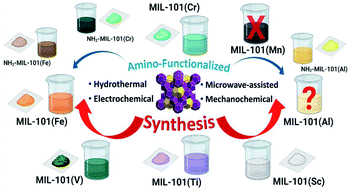Revisiting the MIL-101 metal–organic framework: design, synthesis, modifications, advances, and recent applications
Abstract
Metal–organic frameworks (MOFs) have expanded into a burgeoning topic in materials science and engineering. Their success mostly stems from the versatility of their structure that can be diversely designed by precise control over the assembly. We conduct a critical review on the design and synthesis of MIL-101 MOFs, assessing the viability and applications of their diversified structures. Previous reviews are limited to the MIL-101(Cr). On the contrary, this study presents the synthesis strategies, the merits, and the limitations of the different MIL-101 metal analogues, including Fe, Al, V, Ti, Sc, and Mn. Furthermore, we review the literature on the multivariate type of MIL-101 (MTV-MIL-101), whereby pairwise combinations of metals are involved in the framework. We discuss how the synthesis parameters such as temperature, medium pH, and ratios of precursors intimately influence the final product characteristics. This study moreover presents the effects of changes in these parameters on the final framework structure. For instance, other polymorphs like MIL-88, MIL-53, MOF-235, MIL-47, and MIL-67 were detected in the final product. Finally, the recent applications of MIL-101 in adsorption, catalysis, photocatalysis, membrane preparation, sensor design, and drug delivery are presented and discussed.

- This article is part of the themed collections: Journal of Materials Chemistry A Recent Review Articles and Journal of Materials Chemistry A HOT Papers


 Please wait while we load your content...
Please wait while we load your content...